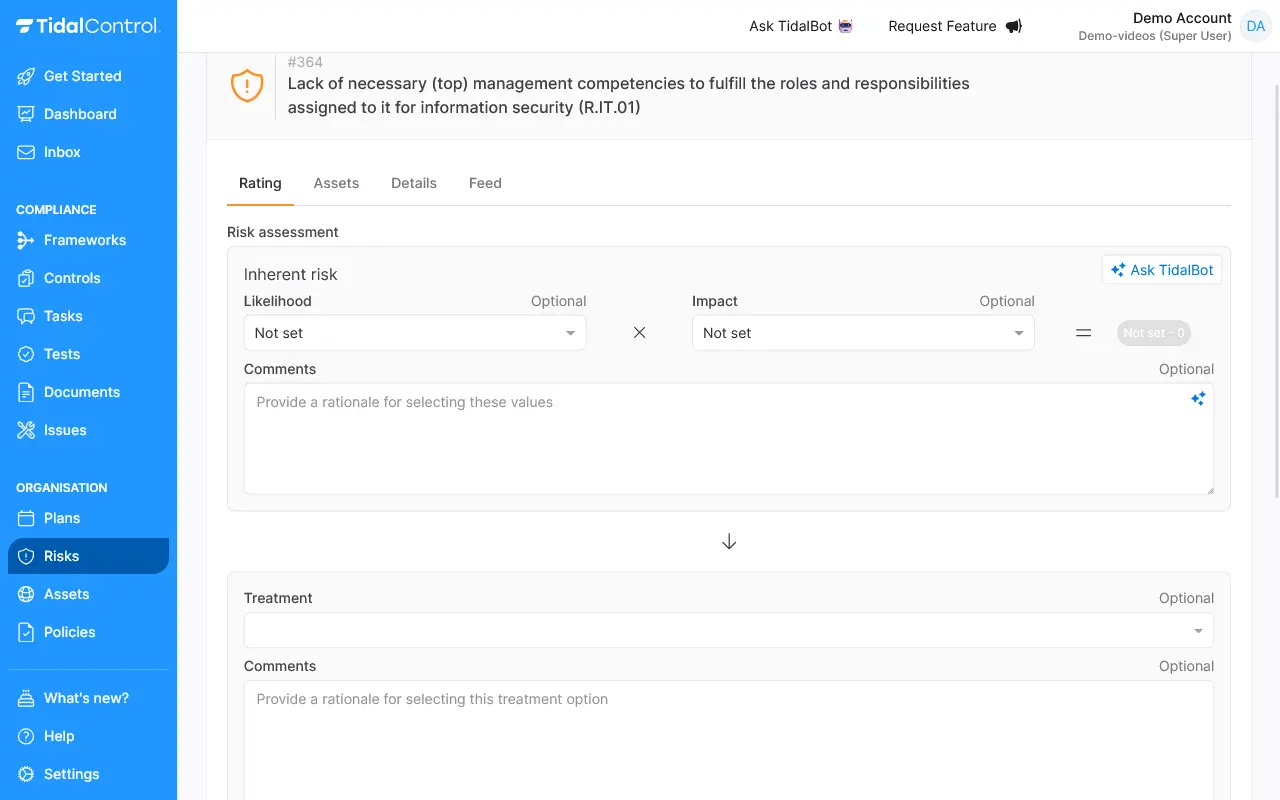Guides
Performing a Risk Assessment
title: Performing a Risk Assessment description: Guide how to perform a risk assessment in Tidal Control sidebar_position: 2
What is a risk assessment?
A risk assessment is a systematic process used to identify, evaluate, and prioritize potential risks that could affect an organization's objectives, operations, or assets. It involves analyzing threats, vulnerabilities, and the potential impact of those risks to mitigate or minimize them effectively.
A risk assessment is conducted at least once a year, or more frequently in the case of significant organisational changes, significant change in technology, change of business objectives, changes in the business environment, etc.
The process involves the following steps:
- Identify Risks: The first step in a risk assessment process is to identify potential risks. This can be done through various methods such as brainstorming, reviewing historical data and recent events, and using or consulting industry standards and best practices.
- Analyse Risks: Once potential risks have been identified, the next step is to analyse them to determine their likelihood and potential impact. This step involves gathering additional information about the risks and evaluating their potential consequences.
- Evaluate Risks: The next step is to evaluate them by comparing the likelihood and potential impact of each risk against our risk acceptance criteria. This step helps to understand which risks are acceptable, and determine which risks are the most critical and require immediate attention.
- Develop Mitigation Strategies: The next step is to develop strategies to mitigate the unacceptable risks that have been identified. This may include implementing controls to reduce the likelihood of the risk occurring, or developing contingency plans to manage the risk if it does occur.
- Monitor and Review: The final step in the risk assessment process is to monitor and review the effectiveness of the risk management strategies that have been implemented. This step involves regularly monitoring the risks and assessing whether the mitigation strategies are working effectively, and making changes as necessary.
What is the purpose of conducting a risk assessment?
The purpose of a risk assessment is to systematically identify, evaluate, and mitigate potential risks that could impact an organization's ability to meet regulatory, legal, and operational requirements. Without doing a risk assessment you will not know the vulnerabilities in your organization that can pose a threat.
A proper risk assessment is conducted in Tidal Control by:
- Click on the Risks tab on the left side of the portal
- Click on the risk that needs to be assessed
- Assess inherent risks, this assesses the risk associated with any system or process without any mitigating or controls actions applied to them. If you are unsure how to proceed with it, you may ask the Tidal AI to guide you through it. It can even assess the risk based on the company information you provided to the Tidal portal!
- Assess the treatment by selecting one of the 4 options to treat the risk with: accept, avoid, reduce, or transfer
- Assess residual risks, this assesses the risk associated with any system or process after implementing risk mitigating actions or controls against the risks
By measuring inherent and residual risk, organizations can see how much risk has been reduced through applying controls. Organizations can also identify any gaps in risk treatment that may exist.
